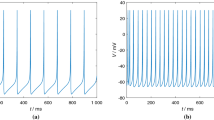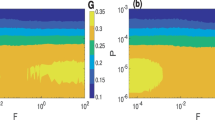Abstract
Inspired by the nervous system working mechanism of a biological brain, brain-like intelligence has been a research frontier in the field of artificial intelligence. Under external stimulation, biological brains have self-adaptive advantages. Drawing from the advantage of biological brains, it is meaningful to investigate the anti-interference ability of brain-like models. In this study, we proposed a spiking neural network with small-world topology (SWSNN), where Izhikevich neuron models and synaptic plasticity models with excitatory and inhibitory synapses are introduced to represent nodes and edges of the network, respectively. The anti-interference ability of the SWSNN against pulse noise is investigated, and the anti-interference ability of SNNs with different topologies are compared. The simulation results indicate that: (i) our SWSNN has anti-interference ability against pulse noise, which is supported from different perspectives based on two indices. Furthermore, the chain reaction of firing rates, synaptic weights and topological characteristics forms neural information processing in the SWSNN under pulse noise. In addition, the synaptic weights are significantly relevant to the anti-interference ability, which implies that an intrinsic factor of the anti-interference ability is the dynamic regulation of synaptic plasticity. (ii) Our SWSNN outperforms the random and regular SNNs that are not complex networks in terms of anti-interference performance. For complex network, the anti-interference performance of SWSNN is superior to that of scale-free SNN, and the anti-interference superiority of the SWSNN is more obvious with the increase of amplitude of pulse noise. The topological characteristics of the network are further discussed, and the results imply that the topology is a factor that affects the anti-interference performance of the SWSNN.












Similar content being viewed by others
References
Codocedo JF, Inestrosa NC (2016) Environmental control of micrornas in the nervous system: implications in plasticity and behavior. Neurosci Biobehav Rev 60:121–138. https://doi.org/10.1016/j.neubiorev.2015.10.010
Ham TR, Farrag M, Leipzig ND (2017) Covalent growth factor tethering to direct neural stem cell differentiation and self-organization. Acta Biomaterialia 53:140–151. https://doi.org/10.1016/j.actbio.2017
Wang S, Wang H, Zhao D, Liu X, Yan W, Wang M et al (2019) Grey matter changes in patients with vestibular migraine. Clin Radiol 74(11):898.e1–898.e5. https://doi.org/10.1016/j.crad.2019.07
Jang H, Simeone O, Gardner B, Gruning A (2019) An introduction to probabilistic spiking neural networks: probabilistic models, learning rules, and applications. IEEE Signal Process Mag 36(6):64–77. https://doi.org/10.1109/MSP
Deng W, Huang K, Yang C (2019) Effect of clustering property on complex network reconstruction via compressed sensing. Physica A 528:121357. https://doi.org/10.1016/j.physa
Gautam A, Singh V (2020) CLR-based deep convolutional spiking neural network with validation based stopping for time series classification. Appl Intell 50:830–848. https://doi.org/10.1007/s10489-019-01552-y
Hussain I, Thounaojam DM (2021) WOLIf: an efficiently tuned classifier that learns to classify non-linear temporal patterns without hidden layers. Appl Intell 51:2173–2187. https://doi.org/10.1007/s10489-020-01934-7
Hodgkin AL, Huxley AF (1952) A quantitative description of membrane current and its application to conduction and excitation in nerve. J Physiol 117(4):500–544. https://doi.org/10.1007/BF02459568
Brette R, Gerstner W (2005) Adaptive exponential integrate-and-fire model as an effective description of neuronal activity. J Neurophysiol 94(5):3637–3642. https://doi.org/10.1152/jn.00686
Izhikevich E M (2003) Simple model of spiking neurons. IEEE Trans Neural Netw 14(6):1569–1572. https://doi.org/10.1109/TNN.2003.820440https://doi.org/10.1109/TNN.2003.820440
Gabrieli D, Schumm SN, Vigilante NF, Parvesse B, Meaney DF (2020) Neurodegeneration exposes firing rate dependent effects on oscillation dynamics in computational neural networks. Plos One 15 (9):e0234749. https://doi.org/10.1371/journal.pone.0234749
Takahashi M (2019) Izhikevich model-based self-repairing control for plants with sensor failures and disturbances. J Robot Netw Artif Life 6(2):105–108. https://doi.org/10.2991/jrnal.k.190828.007https://doi.org/10.2991/jrnal.k.190828.007
Kim SY, Lim W (2018) Effect of spike-timing dependent plasticity on stochastic burst synchronization in a scale-free neuronal network. Cogn Neurodyn 12(3):315–342. https://doi.org/10.1007/s11571-017-9470-0https://doi.org/10.1007/s11571-017-9470-0
Górski T, Veltz R, Galtier M, Fragnaud H, Goldman JS, Teleńczuk B et al (2018) Dendritic sodium spikes endow neurons with inverse firing rate response to correlated synaptic activity. J Comput Neurosci 45(3):223–234. https://doi.org/10.1007/s10827-018-0707-7https://doi.org/10.1007/s10827-018-0707-7
Yang S, Govindaiah G, Lee S H, Yang S, Cox C L (2017) Distinct kinetics of inhibitory currents in thalamocortical neurons that arise from dendritic or axonal origin. PloS One 12(12):e0189690. https://doi.org/10.1371/journal.pone.0189690
Dargaei Z, Liang X, Serranilla M, Santos J, Woodin MA (2019) Alterations in hippocampal inhibitory synaptic transmission in the r6/2 mouse model of huntington’s disease. Neuroscience 404:130–140. https://doi.org/10.1016/j.neuroscience.2019.02.007
Hong C, Wei X, Wang J, Deng B, Yu H, Che y (2019) Training spiking neural networks for cognitive tasks: a versatile framework compatible with various temporal codes. IEEE Trans Neural Netw Learn Syst 31(4):1285–1296. https://doi.org/10.1109/TNNLS.2019.2919662
Yangm X, Lin J, Zheng W, Zhao J, Ji M, Lei Y et al (2020) Research on learning mechanism designing for equilibrated bipolar spiking neural networks. Artif Intell Rev 53:189–5215. https://doi.org/10.1007/s10462-020-09818-5
Barthelemy M (2018) Morphogenesis of spatial networks. Berlin, germany
Habibulla Y (2020) Statistical mechanics of the directed 2-distance minimal dominating set problem. Commun Theor Phys 72(9):095602. https://doi.org/10.1088/1572-9494/aba249
Li Z, Ren T, Xu Y, Jin J (2018) The relationship between synchronization and percolation for regular networks. Phys A: Stat Mech Appl 492:375381. https://doi.org/10.1016/j.physa.2017.10.003
Watts DJ, Strogatz SH (1998) Collective dynamics of small-world networks. Nature 393 (6684):440442. https://doi.org/10.1038/30918https://doi.org/10.1038/30918
Greenbury SF, Johnston IJ, Smith MA, Doye JPK, Louis A (2010) A the effect of scale-free topology on the robustness and evolvability of genetic regulatory networks. J Theor Biol 267(1):4861. https://doi.org/10.1016/j.jtbi
Li G, Luo Y, Zhang Z, Xu Y, Jiao W, Jiang Y, Huang S, Wang C (2019) Effects of mental fatigue on small-world brain functional network organization. Neural plasticity. pp 1716074. https://doi.org/10.1155/2019/1716074
Hu QL, Wang XB, Li YF, Song YJ, Meng FH et al (2020) Analysis of brain structural network of patients with mild cognitive impairment based on DTI. Chin J Med Imaging Technol 36(7):986–990. https://doi.org/10.13929/j.issn.1003-3289.2020
Lei X, Wang Y, Yuan H, Chen A (2015) Brain scale-free properties in awake rest and NREM sleep: a simultaneous EEG/fMRI study. Brain Topogr 28(2):292–304. https://doi.org/10.1007/s10548-014-0399-x
Li WJ, Chu MH, Qiao JF (2020) A pruning feedforward small-world neural network based on Katz centrality for nonlinear system modeling. Neural Netw 130:269–285. https://doi.org/10.1016/j.neunet
Bennett A, White A (2021) Dynamical properties of spiking neural networks with small world topologies. Procedia Comput Sci 190:71–81. https://doi.org/10.1016/J.PROCS
Reis AS, Brugnago EL, Caldas IL, Batista AM, Iarosz KC, Ferrari FA, Viana RL (2021) Suppression of chaotic bursting synchronization in clustered scale-free networks by an external feedback signal. Chaos: an Interdisciplinary Journal of Nonlinear Science 31(8):083128. https://doi.org/0.1063/5
Emmert K, Breimhorst M, Bauermann T, Birklein F, Rebhorn C, Van D et al (2017) Active pain coping is associated with the response in real-time fMRI neurofeedback during pain. Brain Imaging Behav 11(3):712721. https://doi.org/0.1007/s11682-016-9547-0
Sherwood MS, Parker JG, Diller EE, Ganapathy S, Bennett KB, Esquivel CR et al (2019) Self-directed down-regulation of auditory cortex activity mediated by real-time fMRI neurofeedback augments attentional processes, resting cerebral perfusion, and auditory activation. NeuroImage 195:475489. https://doi.org/10.1016/j.neuroimage.2019.03.078
Tik M, Hoffmann A, Sladky R, Tomova L, Hummer A, de Lara LN et al (2017) Towards understanding rTMS mechanism of action: stimulation of the DLPFC causes network-specific increase in functional connectivity. NeuroImage 162:289296. https://doi.org/10.1016/jneuroimage.2017.09.022
Etémé AS, Tabi CB, Mohamadou A (2019) Firing and synchronization modes in neural network under magnetic stimulation. Commun Nonlinear Sci Numer Simul 72:432440. https://doi.org/10.1016/j.cnsns.2019.01.004
Zhang X, Liu S (2018) Stochastic resonance and synchronization behaviors of excitatory-inhibitory small-world network subjected to electromagnetic induction. Chin Phys B 27(4):040,501. https://doi.org/CNKI:SUN:ZGWL.0.2018-04-025
Guo L, Hou LT, Wu YX, Lv H, Yu HL (2020) Encoding specificity of scale-free spiking neural network under different external stimulations. Neurocomputing 418:126–138. https://doi.org/10.1016/j.neucom.2020.07.111
Chen C, Ma Y, Ren G (2019) A convolutional neural network with fletcher–reeves algorithm for hyperspectral image classification. Remote Sens 11(11):1325. https://doi.org/10.3390/rs11111325
Gong J, Jin J (2021) A faster and better robustness zeroing neural network for solving dynamic Sylvester equation. Neural processing letters. pp 1–16. https://doi.org/10.1007/s11063-021-10516-8
Patel D, Hazan H, Saunders DJ et al (2019) Improved robustness of reinforcement learning policies upon conversion to spiking neuronal network platforms applied to Atari breakout game. Neural Netw 120:108–115. https://doi.org/10.1016/j.neunet.2019.08.009
Mansouri-Benssassi E, Ye J (2021) Generalisation and robustness investigation for facial and speech emotion recognition using bio-inspired spiking neural networks. Soft Comput 25 (3):1717–1730. https://doi.org/10.1007/s00500-020-05501-7
Guo L, Kan E, Wu Y et al (2020) Noise suppression ability and its mechanism analysis of scale-free spiking neural network under white Gaussian noise. Plos One 15(12):e0244683. https://doi.org/10.1371/journal.pone.0244683
Liu D, Guo L, Wu Y et al (2020) Anti-interference function of scale-free spiking neural network under AC magnetic field stimulation. IEEE Trans Mag 57(2):1–5. https://doi.org/10.1109/TMAG.2020.3013258https://doi.org/10.1109/TMAG.2020.3013258
Watts DJ, Strogatz SH (1998) Collective dynamics of small-world networks. Nature 393 (6684):440442. https://doi.org/10.1038/30918https://doi.org/10.1038/30918
Izhikevich EM (2004) Which model to use for cortical spiking neurons? IEEE Trans Neural Netw 15(5):1063–1070. https://doi.org/10.1109/tnn.2004.832719
Gkoupidenis P, Schaefer N, Strakosas X, Fairfield JA, Malliaras GG (2015) Synaptic plasticity functions in an organic electrochemical transistor. Appl Phys Lett 107(26):263302. https://doi.org/10.1063/1.4938553
Song S, Miller KD, Abbott LF (2000) Competitive hebbian learning through spike-timing-dependent synaptic plasticity. Nat Neurosci 3(9):919–926. https://doi.org/10.1038/78829
Zhou HZ, Li XW (2021) Research on small-world network communication of public sentiment by self-media based on energy model. Adv Sci Technol 6258:249–262. https://doi.org/10.4028/WWW.SCIENTIFIC.NET/AST.105.249
Varshney LR, Chen BL, Paniagua E, Hall DH, Chklovskii DB (2011) Structural properties of the caenorhabditis elegans neuronal network. PLoS Computational Biology, 7(2). https://doi.org/10.1371/journal.pcbi.1001066
Humphries G (2008) Network small-world-ness: a quantitative method for determining canonical network equivalence. PLOS ONE 3(4):002051. https://doi.org/10.1371/journal.pone.0002051
Bin S, Sun G, Chen C (2019) Analysis of functional brain network based on electroencephalography and complex network. Microsystem technologies. pp 1–9. https://doi.org/10.1007/s00542-019-04424-0https://doi.org/10.1007/s00542-019-04424-0
Kumar A, Singh SS, Singh K, Biswas B (2019) Level-2 node clustering coefficient-based link prediction. Appl Intell 49(7):622779. https://doi.org/10.1007/s10489-019-01413-8
Vogels TP, Sprekeler H, Zenke F, Clopath C, Gerstner. W (2011) Inhibitory plasticity balances excitation and inhibition in sensory pathways and memory networks. Science 334(6062):691573. https://doi.org/10.1126/science.1211095
Barrat A, Barthelemy M, Pastor-Satorras R, Vespignani A (2004) The architecture of complex weighted networks. Proc Natl Acad Sci 101(11):473752. https://doi.org/10.1073/pnas.0400087101
Wang B, Tang H, Zhang Z (2005) Evolving scale-free network model with tunable clustering. Int J Modern Phys B 19(26):3951–3959. https://doi.org/10.1142/S0217979205032437
Eguiluz VM, Chialvo DR, Cecchi GA, Baliki M, Apkarian AV (2005) Scale-free brain functional networks. Phys Rev Lett 94:018102. https://doi.org/10.1103/PhysRevLett.94.018102,018102https://doi.org/10.1103/PhysRevLett.94.018102,018102
Acknowledgements
This work was supported by the National Natural Science Foundation of China under Grants 52077056, 61976240 and 51977060 and the Natural Science Foundation of Hebei Province under Grant E2020202033.
Author information
Authors and Affiliations
Contributions
Conceptualization: Lei Guo; Methodology: Lei Guo; Formal analysis and investigation: Lei Guo, Yihua Song; Writing-original draft preparation: Yihua Song; Writing-review and editing: Youxi Wu; Funding acquisition: Lei Guo, Youxi Wu, Guizhi Xu; Supervision: Guizhi Xu.
Corresponding author
Ethics declarations
Ethics Approval
The authors declared that we have independently written programs to construct our network and performed the research and analysis of the anti-interference ability of our network.
Consent for Publication
The authors agree to publication in the Journal of Applied Intelligence and also to publication of the article in English by Springer in Springer’ s corresponding English-language journal.
Conflict of Interests
The authors declare that they have no conflict of interest.
Additional information
Availability of Data and Materials
The authors declared that we have independently written programs to construct our network and performed the research and analysis of the anti-interference ability of our network. There are no additional data sources used in this paper.
Publisher’s note
Springer Nature remains neutral with regard to jurisdictional claims in published maps and institutional affiliations.
Rights and permissions
About this article
Cite this article
Guo, L., Song, Y., Wu, Y. et al. Anti-interference of a small-world spiking neural network against pulse noise. Appl Intell 53, 7074–7092 (2023). https://doi.org/10.1007/s10489-022-03804-w
Accepted:
Published:
Issue Date:
DOI: https://doi.org/10.1007/s10489-022-03804-w




